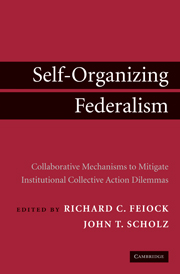 Self-Organizing Federalism
Self-Organizing Federalism Book contents
- Frontmatter
- Contents
- List of Figures
- List of Tables
- Contributors
- Preface
- PART ONE SELF-ORGANIZING VERSUS CENTRALIZED SOLUTIONS TO INSTITUTIONAL COLLECTIVE ACTION PROBLEMS: THEORETICAL CONSIDERATIONS
- 1 Self-Organizing Governance of Institutional Collective Action Dilemmas: An Overview
- 2 Can Consolidation Preserve Local Autonomy? Mitigating Vertical and Horizontal Dilemmas
- 3 The Institutional Collective Action Perspective on Self-Organizing Mechanisms: Market Failures and Transaction Cost Problems
- 4 Conflict, Power, and Irreconcilable Preferences: Some Limits to Self-Organizing Mechanisms
- PART TWO INTEGRATING METROPOLITAN SERVICE PROVISION: NETWORKS, CONTRACTS, AGREEMENTS, AND SPECIAL DISTRICTS
- PART THREE INTEGRATING REGIONAL POLICIES THROUGH NETWORKS, JOINT VENTURES, AND PARTNERSHIPS
- PART FOUR SELF-ORGANIZING GOVERNANCE AND INSTITUTIONAL COLLECTIVE ACTION
- References
- Index
2 - Can Consolidation Preserve Local Autonomy? Mitigating Vertical and Horizontal Dilemmas
from PART ONE - SELF-ORGANIZING VERSUS CENTRALIZED SOLUTIONS TO INSTITUTIONAL COLLECTIVE ACTION PROBLEMS: THEORETICAL CONSIDERATIONS
Published online by Cambridge University Press: 29 January 2010
- Frontmatter
- Contents
- List of Figures
- List of Tables
- Contributors
- Preface
- PART ONE SELF-ORGANIZING VERSUS CENTRALIZED SOLUTIONS TO INSTITUTIONAL COLLECTIVE ACTION PROBLEMS: THEORETICAL CONSIDERATIONS
- 1 Self-Organizing Governance of Institutional Collective Action Dilemmas: An Overview
- 2 Can Consolidation Preserve Local Autonomy? Mitigating Vertical and Horizontal Dilemmas
- 3 The Institutional Collective Action Perspective on Self-Organizing Mechanisms: Market Failures and Transaction Cost Problems
- 4 Conflict, Power, and Irreconcilable Preferences: Some Limits to Self-Organizing Mechanisms
- PART TWO INTEGRATING METROPOLITAN SERVICE PROVISION: NETWORKS, CONTRACTS, AGREEMENTS, AND SPECIAL DISTRICTS
- PART THREE INTEGRATING REGIONAL POLICIES THROUGH NETWORKS, JOINT VENTURES, AND PARTNERSHIPS
- PART FOUR SELF-ORGANIZING GOVERNANCE AND INSTITUTIONAL COLLECTIVE ACTION
- References
- Index
Summary
Political scientists have long debated the benefits and costs of federal systems in which authority is fragmented and decision-making units have overlapping jurisdictions (e.g., Riker 1964; Ostrom 1973; Weingast 1995). While federalism is a touchstone for those working on the institutional design of the polity, the problem is really one of optimal delegation when one wants subunits to coordinate their actions in forming and implementing policy. The empirical chapters in this book discuss the ways that relatively independent authorities can craft institutions and agreements that help achieve coordination without having to rely on a hierarchical authority (a coordinator). These chapters offer a range of views on these arrangements – on the role of metropolitan authorities in crafting interorganizational water arrangements, on the role of special districts in forging cooperative agreements for public goods production, and on networks of contractors in emergency management. One way we think about the range of activities these studies describe is that relatively independent authorities “self-organize” in ways that help overcome coordination problems when the overall system of authority is fragmented. This kind of self-organization is probably dynamic and possibly efficient. The focus of this essay is on the delegation relationships that underpin these organizational forms. My central claim is that this kind of self-organization is neither inevitable nor unbounded, since comparable levels of coordination can be obtained under central authorities utilizing the franchising principle.
I focus on the tension between authority that is horizontally fragmented and authority that is vertically fragmented.
- Type
- Chapter
- Information
- Self-Organizing FederalismCollaborative Mechanisms to Mitigate Institutional Collective Action Dilemmas, pp. 33 - 50Publisher: Cambridge University PressPrint publication year: 2009
- 1
- Cited by
